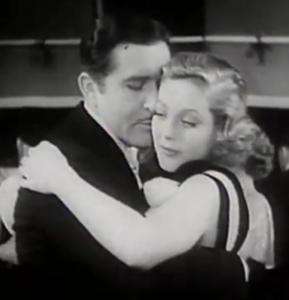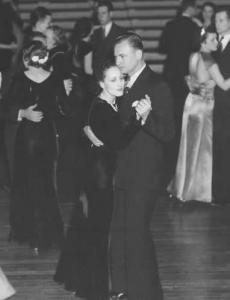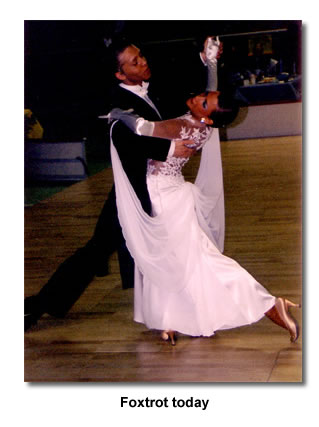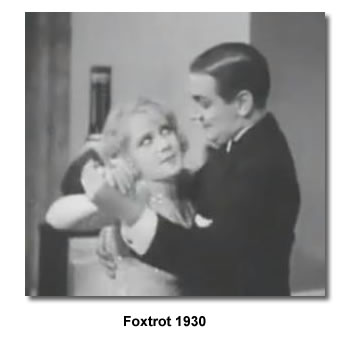Foxtrotting and Why it's Cool to be a Grown-up
 It's not a stunning revelation to say that dancing has changed a lot in the last half century. We all know that, but I don't know that most of us have really thought about the ways it has changed and how it reflects the ways our world has changed.
It's not a stunning revelation to say that dancing has changed a lot in the last half century. We all know that, but I don't know that most of us have really thought about the ways it has changed and how it reflects the ways our world has changed.
"Back in the day" which for my purposes, I will encapsulate in the 50 years between 1910 and 1960, dancing played a central role in the social lives of mature adults which it has entirely lost today. Today, among adults, with a few notable exceptions, almost nobody dances. Back then, almost everyone danced.
Night clubs, hotels, ocean liners and any place where people gathered to socialize had live music and a dance floor. Municipalities, corporations, fraternal lodges and community organizations sponsored dinner dances, where people got dressed up and men and women danced together - and their "signature" dance - by far the most popular and pervasive, was the Foxtrot. The dance floor was often too small, and it was crowded, but it was crowded precisely because almost everyone danced.
Starting in the early 20th Century, there was a clear distinction between Youth Dances and Adult Dances. The kids did the Charleston which became Collegiate, which became Swing, which became Rock & Roll (a species of Swing). Adults danced the Foxtrot, Tango and Waltz (but mostly Foxtrot) and occasionally Latin dances like Rumba, Samba, Cha Cha etc.(all fall in a category now referred to as "Ballroom Dances"). There was a distinctly adult way to dance and a distinctly kid way to dance, and when kids grew up, they gave up the wild kicks, spins, leaps and flying skirts and settled into a style more appropriate to their adult lives. We often refer to "Youth Culture" and tend fix on that when defining past decades in our minds, but we tend to overlook the fact that there was once an "Adult Culture" as well, which was much more ubiquitous and influential than the fads of wild youth.
Adult Culture focused on a sense of sophistication: behaving in a self-assured manner, dressing and presenting yourself well and approaching things like liquor and sex in a knowing way. It was not stodgy, it was nuanced and self-aware. The intimate, free flowing and smooth Foxtrot was the perfect accent to these cocktails, cigarettes, elegant suits and gowns, good conversations, flirtations and occasional seductions.
 Today, kids still dance (I will restrain the curmudgeonly urge to pass judgment on kids today, their hair and their music) but when adults get together nowadays, and dancing actually happens (a comparatively rare occurrence), they put on Oingo Boingo or the Bee Gees, crank it up really loud and a few folks, mostly women, dance like they did in High School. The distinction between adult dancing and kids' dancing is no more. Now there are only current kids and '60 kids, '70s kids, '80s kids, '90s kids etc. This goes hand-in-hand with increasing informality in dress and manners a vague sense that how ever old you are, the grown ups are those people who are older than you. The baby boomers rejected "establishment" Adult Culture, but really had nothing to put in its place.
Today, kids still dance (I will restrain the curmudgeonly urge to pass judgment on kids today, their hair and their music) but when adults get together nowadays, and dancing actually happens (a comparatively rare occurrence), they put on Oingo Boingo or the Bee Gees, crank it up really loud and a few folks, mostly women, dance like they did in High School. The distinction between adult dancing and kids' dancing is no more. Now there are only current kids and '60 kids, '70s kids, '80s kids, '90s kids etc. This goes hand-in-hand with increasing informality in dress and manners a vague sense that how ever old you are, the grown ups are those people who are older than you. The baby boomers rejected "establishment" Adult Culture, but really had nothing to put in its place.
When Adult Culture faded away and the general population of adults gave up on Foxtrots and their ilk, which they did, more or less, in the '60s, ballroom dancing underwent a fundamental transformation. When the Foxtrot was no longer just a thing people did as a matter of course, it became the purview of specialist dance teachers, and since it was no longer about preparing people for regular social interaction, the focus shifted to the dynamics of competition. Competitive ballroom dancing moved the focus away from a pleasant interplay between two people towards showmanship - a show that had very clearly defined steps, exaggerated postures, routines, rules, requirements and definitions of what is correct and what is wrong. If your dancing is to be judged in competition, it must have defined standards, so teaching becomes an exercise in enforcing those standards: teaching to the test.
The Foxtrot of today has evolved into a very complex, performance oriented dance that is very different from the dance that was the property of the whole society. Back in the day, partners were interchangeable and it was expected that you would dance with as many different people as circumstances allowed. Today, when it is essential that both partners know the same routines and are likely to move their feet in the same combination of "quicks" and "slows", those few folks who still Foxtrot tend to stick with the same partners, both from technical necessity and in some cases a sense that switching partners is a sort of cheating - which is the antithesis of social dancing.
 I have said that the Foxtrot has been changed and spoken of it in generalities, but now I really should make some mention of how it was danced by the adults of a bygone age.
I have said that the Foxtrot has been changed and spoken of it in generalities, but now I really should make some mention of how it was danced by the adults of a bygone age.
First, it was a very relaxed and intimate dance. There was no one "right" way to hold your partner and the only constant was that you danced very close together. The partners were in body-to-body contact, and there was no "frame" and "dynamic tension". If they were of matching heights, and the woman leaned forward, they really were dancing cheek-to-cheek (or lips to cheek as in the picture at the top); or as in the picture above, a shorter woman could rest her head on a taller man's chest. The posture and level of intimacy was entirely up to the dancers.
Second, in a time when almost everyone danced, it only follows that they would do a dance that almost everyone could do. While there were step patterns and many possible routines, these were entirely optional. The essence of the dance was walking to the music while the leader used his close contact to lead his partner anywhere his fancy took them. It was a very unstructured and free-flowing dance, and the "slow-slow-quick-quick" and similar step patterns were simply options for the ambitious advanced dancer. The basic Foxtrot was very accessible, and being such a blank slate, marginal dancers could have a simple, low-stress and pleasant turn around the floor while skillful dancers could give their talents free rein.
And finally, it was a conversation between two people. It was not a show so it didn't have as much of the "performance anxiety" that keeps a lot of moderns, especially men, off the dance floor. They didn't do underarm twirls or much of anything that caused them to separate and take up more than their fair share of crowded dance floor space, and they didn't dance like they were playing to some theoretical audience. They just relaxed and glided across the floor together. They were cool, they were smooth, they were sophisticated and they were sexy, or at least that's how they felt, and that's really what matters.
I am very involved these days in the "Art Deco Society". Folks in this community are fond of dressing up in stylish and classy "vintage attire", sipping cocktails and often dancing. I think most of the people who do various forms of historical costumed activities do it so they can borrow from the past something they feel is missing from their modern world. With the "Deco" crowd, I think the thing they are missing most is an Adult Culture - a space where being an adult is cool. I think that's also why many others have been drawn to the "Mad Men" world of the early '60s. We've been exuberant and insecure teenagers. We want to be suave, sophisticated adults.
You're looking stunning in that new gown my dear. Care for a cocktail? Is that a Foxtrot I hear?
Want to know more?
How to dance the adult dances of the Jazz Age
Walter Nelson
A video overview of the Jazz Age Fox Trot.
